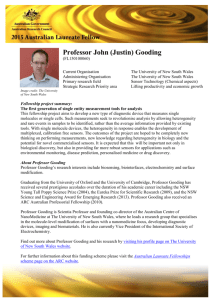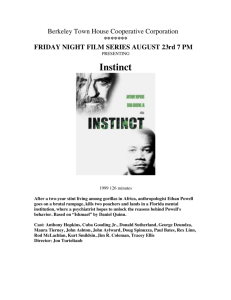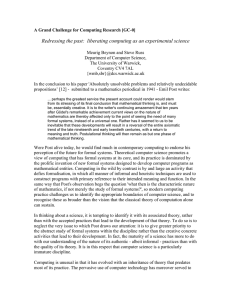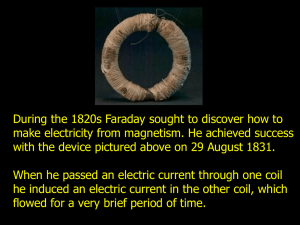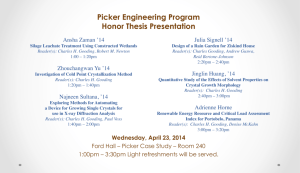Some Historical Encouragement for TTC: Alchemy, the Calculus and Electromagnetism David Gooding
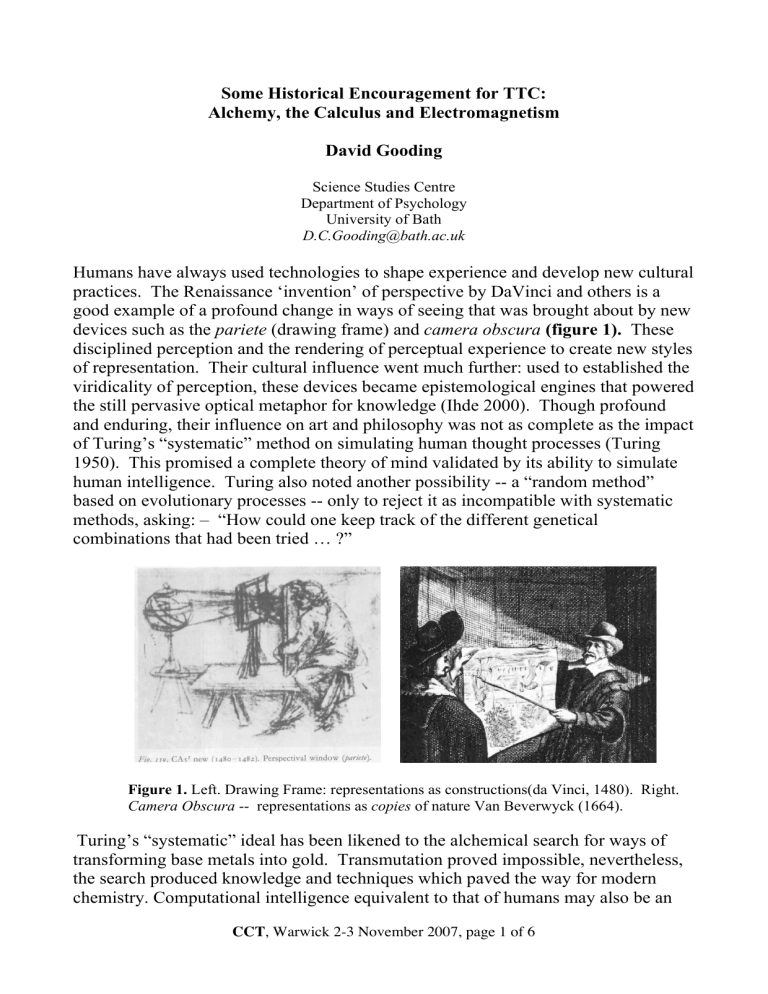
Some Historical Encouragement for TTC:
Alchemy, the Calculus and Electromagnetism
David Gooding
Science Studies Centre
Department of Psychology
University of Bath
D.C.Gooding@bath.ac.uk
Humans have always used technologies to shape experience and develop new cultural practices. The Renaissance ‘invention’ of perspective by DaVinci and others is a good example of a profound change in ways of seeing that was brought about by new devices such as the pariete (drawing frame) and camera obscura (figure 1). These disciplined perception and the rendering of perceptual experience to create new styles of representation. Their cultural influence went much further: used to established the viridicality of perception, these devices became epistemological engines that powered the still pervasive optical metaphor for knowledge (Ihde 2000). Though profound and enduring, their influence on art and philosophy was not as complete as the impact of Turing’s “systematic” method on simulating human thought processes (Turing
1950). This promised a complete theory of mind validated by its ability to simulate human intelligence. Turing also noted another possibility -- a “random method” based on evolutionary processes -- only to reject it as incompatible with systematic methods, asking: – “How could one keep track of the different genetical combinations that had been tried … ?”
Figure 1.
Left. Drawing Frame: representations as constructions(da Vinci, 1480). Right.
Camera Obscura -- representations as copies of nature Van Beverwyck (1664).
Turing’s “systematic” ideal has been likened to the alchemical search for ways of transforming base metals into gold. Transmutation proved impossible, nevertheless, the search produced knowledge and techniques which paved the way for modern chemistry. Computational intelligence equivalent to that of humans may also be an
CCT , Warwick 2-3 November 2007, page 1 of 6
impossible objective, but it has already generated a lot of science and technology.
Yet the comparison is unfair: chemistry took some 200 years to emerge as a discipline and the many fields of chemistry as we know them, a further 200.
Consider that he first computational simulation to be accepted in lieu of a mathematical proof -- Ulam’s simulation of one of Teller’s A-bomb models – was made barely 60 years ago (Fox-Keller 2003, Galison 1996).
Representing Representation
I want to offer another case for comparison that is closer to the concerns and aspirations of this meeting. The Empirical Modelling group has promoted the importance of the experienced life-world in human sense-making, drawing on my analysis of the phenomenology of early electromagnetism (Gooding 1990). This required me to study a variety of manuscript and printed sources and – more importantly – to interpret them in the light of experience gained by replicating many of the original experiments (Gooding 1989). In conveying what I found I was confronted by the limitations of static, printed images and text. This was a common problem for scientists: how to capture, express and communicate what has not been described before (somewhat eased by the advent of computational imaging techniques). In 1820 Faraday even complained in print that no-one had been able to describe the new electromagnetic phenomena clearly enough to convey features that could be agreed upon. He resorted to sketches of images, objects and actions ( shown in figure 2A and and procedural explanations and instructions ( figure 2B ). Most effective were the mini-motors that he could mail to scientists around Europe with simple instructions to produce the anomalous electromagnetic rotations (figure 2C) .
These images and devices express ideas that are asserted through the performances aimed at communicating them.
Figure 2.
A .Faraday’s sketches of the early phenomenology of electromagnetism (May-June
1820). B.
His attempts to resolve the forces it terms of repeatable structures (September 1820).
C.
The mini-rotation motor he mailed to other scientists (1821).
CCT , Warwick 2-3 November 2007, page 2 of 6
To capture Faraday’s methods I developed a notion of construals as asserted, quasirepresentations that act both as heuristics (guiding an emerging interpretation of phenomena) and as a basis for communicating and negotiating an emerging understanding (Gooding 1990). Faraday had in fact developed visual reasoning techniques (Gooding 2006) similar to those used by most scientists, before and since
(Gooding 2004).
The process of construing unruly novel phenomena is very slippery. The actors’ accounts change rapidly, as do the historians interpretations of them. To capture this slipperiness – both in the replication of experiments and the many renditions found in diaries, letters and publications – I developed a notation for mapping the interplay of material and mental manipulations for each version. This notation expresses a dynamic process but using it is also imposes some discipline on the interpretation.
To apply the notation consistently forces attention to the process of interpretation and to decisions made by the historian in achieving an interpretation. This process generates graphs that show differences between each iteration of the process of learning to make something new ( figure 3) . It is possible to capture and simulate these nuances computationally (Addis and Gooding 2007, Gooding and Addis 2007) although the essentially visual elements of scientific thinking (Gooding 2004) still elude computational representation.
CVFigure 3.
Diagrammatic representation of one of Faraday’s exploratory pathways to constructing the electric motor (Gooding 1990).
Rationalism vs. Empiricism – Formalism vs. Phenomenological Complexity
The relevance of this episode emerges when we consider the other side of it – the work by A. M.Ampere that did not need to rely on construals, and which generated a
CCT , Warwick 2-3 November 2007, page 3 of 6
formal mathematical theory of electromagnetism within five years of its discovery.
I’ll then suggest some parallels with our concerns about formal computation and its aftermath.
Why was it so vital that Faraday reproduce phenomena in a way that could not be ignored? He was well aware of the long-established tradition of mathematical representation based on Newtonian models of matter and forces. The mathematical techniques required a degree of simplification that Faraday found un-acceptable. To understand this we need to compare Faraday’s experiments with those of Ampere,
Arago and others at the Academie des Sciences in Paris. For his part Ampere was obliged to reject the reality of Faraday’s phenomena, working instead with a “fait primitif”. A ‘primary fact’ is necessary because it is one which makes mathematical analysis possible. One produced primary facts with beautifully engineered devices designed to ensure that no observable phenomenon occurs ( figure 4) . Ampere’s current balances are devices in which all the forces sum to zero, so one can write an empirical equation which sums to zero. This makes it possible to find a function for which the equation is one solution. But nothing is seen to happen. Contrast Faraday’s experiments in which things move, twist, jump – and with some difficulty – are constrained in a dynamic, unstable equilibrium . Nothing sums to zero here.
Faraday’s electrodynamics was mathematically intractable to Ampere.
Figure 4. One of Ampere’s beautifully engineered current balances (1820).
The analogy to the impact of computational constraints on modelling complex, dynamical processes should be obvious. This leads us to ask: Could formal, classical computer science be where electromagnetism was in the 1820s?
Let’s continue the story: Ampere produced a general mathematical theory of part of the experimental domain by 1825, based on experiments in which nothing happens.
His empirical phenomenology is prescribed by constraints inherent in the
CCT , Warwick 2-3 November 2007, page 4 of 6
mathematical methods. Faraday’s busy phenomenology produced a qualitative, visual theory of considerable power and generality – described by James Clerk
Maxwell as mathematics “of a very high order” (Maxwell 1890). It took William
Thomson and Maxwell over twenty years to develop a mathematical representation of equivalent generality to that developed by Ampere and his successors. This included both Ampere’s and Faraday’s work. It drew on ways of representing quantities
(quaternions, as developed into vector calculus) and it required the invention of new notation: the special operators DIV and CURL that express Faradayan, bench-top variables and the direct interaction of electrical, magnetic and pondermotive forces
( figure 5 ). Their new formulation expresses features of the phenomenology – the pushes, pulls and twists that one could feel – as well as general, spatially distributed properties of electric and magnetic forces. The new mathematics of field theory was far from perfect (but was useful in practical applications such as cable telegraphy).
Maxwell’s formulation of 1864 contained formulae which he knew to be correct, but for which he could not produce a full derivation. He also introduced a special term to represent a ‘missing’ quantity needed to balance the equations.
Figure 5.
Faraday’s sketch of 1832 showing the reciprocal relationships of electric, magnetic and ponderomotive forces.
Pragmatism about Formalism
Einstein later objected to the asymmetry this term introduced into Maxwell’s field equations. This was an important prompt for his special theory of relativity. This shows that a formal theory, integrated into the Newtonian mathematical paradigm, could be subjected to profound re-evaluation of its fundamental assumptions. The other part of Einstein’s 1905 critique is very pragmatic: it ha to do with the elementary procedures of establishing simultaneity which, he argued, you can perform consistently only if you assume that the velocity of light is constant.
This mini-history suggests that where the prevailing formalism has constrained the response to complexity in the phenomena (and in the processes whereby we construe them), we can respond in at least two ways: we can reconstruct the phenomenal world to fit, as Ampere did. Writing of mathematical proofs, Lakatos called this the
‘monster barring’ approach (Lakatos 1976). Or we can embrace the monsters and explore alternative approaches to representation. The example of Thomson and
Maxwell shows that this latter approach may take some time. But the case of electromagnetism is hardly unique: the development of infinitesimal calculus was
CCT , Warwick 2-3 November 2007, page 5 of 6
‘forced’ by the need to represent relationships between variable quantities -something that medieval mathematics could not do. Newton and Leibniz solved this problem in the 17th century, producing useable methods two centuries before the fundamental limit theorem was proven in the 19th century (Boyer 1949). In the meantime, workable, if un-proven versions can be used.
Can a similarly pragmatic approach to formalism serve computer science as well as it has served the natural sciences?
References
Addis, T. R. & Gooding, D. C. 2007, “Simulation Methods for an Abductive System in Science”, in
Foundations of Science , 11: 000-000 (in press).
Boyer, C. 1949/1959. The History of the Calculus and its Conceptual Development (New York:
Dover).
Ihde, D. 2000. “Epistemological Engines”, Nature 406 (July), p. 21.
Fox-Keller, E. 2003. “Models, Simulation and ‘Computer Experiments’”, in Radder, H. ed., The
Philosophy of Scientific Experimentation (Pittsburgh).
Galison, P. 1996. Image and Logic. (Chicago: Chicago U.P.)Gooding, D. C. 1989, “History in the
Laboratory: Can we tell what really went on?”, in James, F., ed., The Development of the
Laboratory (London: Macmillan).
Gooding, D. C. 1990. Experiment and the Making of Meaning . (Dordrecht and Boston: Kluwer
Academic).
Gooding, D. C. 2004. “Envisioning Explanations”, Interdisciplinary Science Reviews , 29: 278-94.
Gooding, D. C. 2006. “From Phenomenology to Field Theory: Faraday’s Visual Reasoning”,
Perspectives on Science , 14: 40-65.
Gooding, D. C. & Addis, T. R. 2007, “Modelling Experiments as Mediating Models”, in
Foundations of Science , 11: 000-000, (in press)
Turing, A. M. 1950. “Can a Machine Think?”, Mind (1950), reprinted in Boden, M. ed., 1990, The
Philosophy of Artificial Intelligence (Oxford: OUP)
Lakatos, I. 1976. Proofs and Refutations: the Logic of Mathematical Discovery . (Cambridge:
CUP).
Maxwell, J. C. 1890, “Faraday” (first published in Nature ), reprinted in Niven, W. D. ed., The
Scientific Papers of James Clerk Maxwell , vol. 2, pp. 354-360.
CCT , Warwick 2-3 November 2007, page 6 of 6

